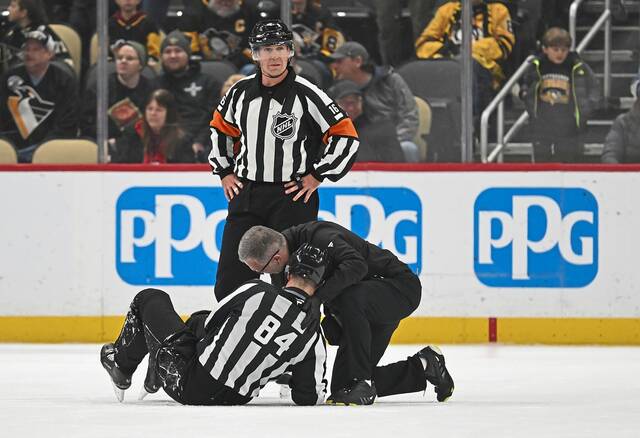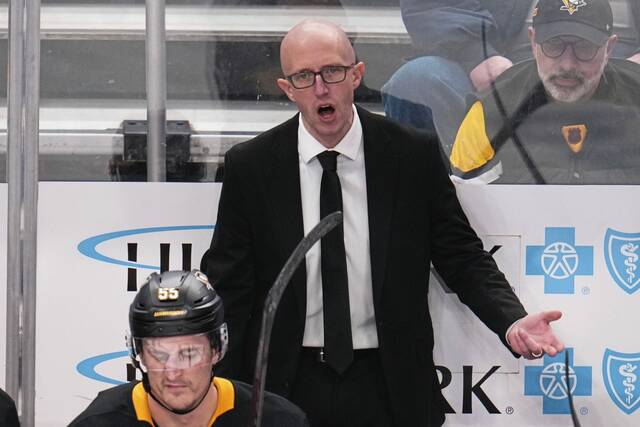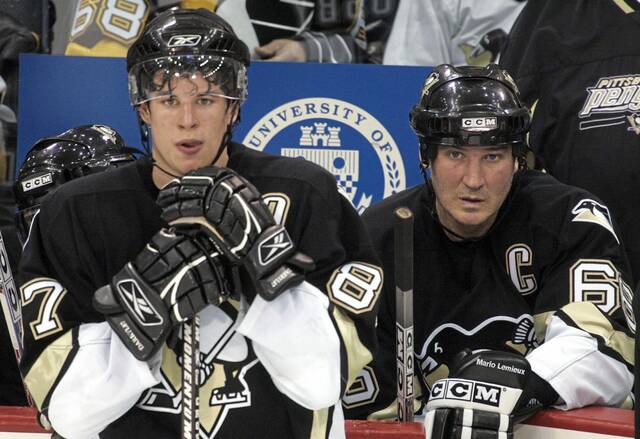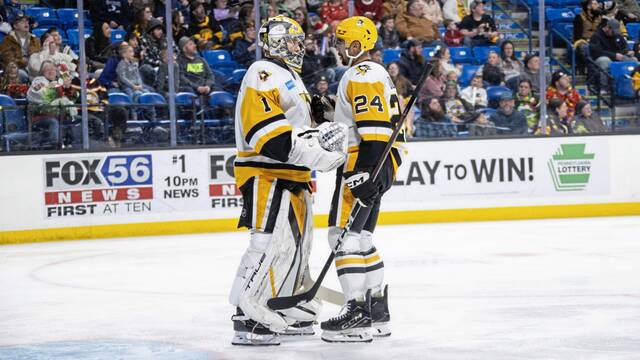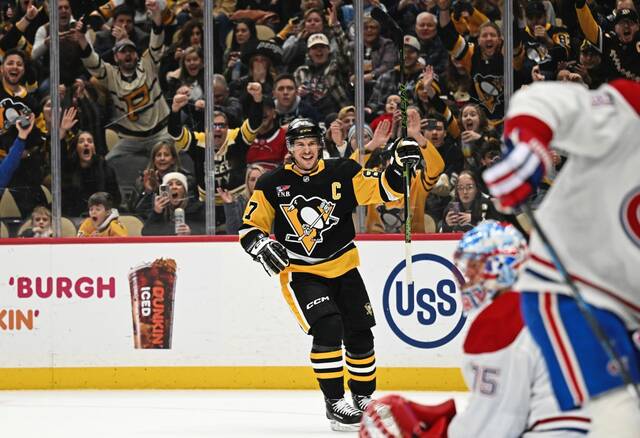Bryan Rust knows his math.
After all, the Penguins forward was a finance major at Notre Dame.
So his choice of verbiage to explain a pass he received from linemate Sidney Crosby in a recent game was fitting.
“Sid’s geometry was pretty good there.”
During the first period of a 7-6 home win against the New Jersey Devils on April 20, Crosby controlled a puck in front of the home penalty box and zipped a cross-ice pass off the opposite wall in front of the visiting bench. The puck caromed past the offensive blue line and was chased down by Rust, who surged past sluggish Devils defenseman Damon Severson, cut across the front of the crease and tucked a forehand shot past goaltender Scott Wedgewood’s left skate for a goal.
Just a textbook tape-to-boards-to-tape pass.
It wasn’t the only time in that contest the Penguins used a bank play to create offense.
During the second period, from the red line, forward Zach Aston-Reese chipped a cross-ice dump-in to the left corner of the offensive zone. Penguins forward Evan Rodrigues hustled past Devils defenseman Ryan Murray, claimed the puck and dealt a backhand pass to the slot for forward Teddy Blueger, who shuffled in a forehand shot for a score.
“On a play like that sometimes, certainly people like to chip it short side and have a guy come across,” Rodrigues said. “Me and (Aston-Reese) just decided to kind of stay wide and blow the zone. He used the backboards. Then I heard Teddy yelling, didn’t really see him. Just kind of put it there, and he did a good job of finishing.”
Said Blueger: “That’s kind of another way to get possession instead of just kind of mindlessly dumping it in. Putting it in an area where your teammate can go get it, and you can make plays right off it.”
To be clear, the Penguins aren’t the only team in the NHL that utilizes bank plays. The other 30 active franchises in the league are well aware there are boards surrounding the ice. But it’s rare to see any one team use them twice in a contest on sequences that lead directly to goals.
And that wasn’t an accident.
“We practice those types of things a lot,” coach Mike Sullivan said. “The play with (Rust), for example, Sid makes a great play just passing behind him. When defensemen have tight gaps, it’s a real effective strategy to make a space play and allow (Rust) an opportunity to skate on a puck. It was just a heads-up play by Sid. It was a great play by (Rust) to finish it off. The same thing with Teddy and (Rodrigues). Those were just heads-up plays. It’s just really taking what the game gives you and trying to identify where the ice is to play on and try to create opportunity by making those types of space plays. You can use the boards to your advantage.”
Part of that is knowing your environment. In addition to scouting the individual players or team-wide schemes, the Penguins try to keep tabs on what the boards are like in each venue.
“That’s something that we discuss consistently,” Sullivan said. “Not only do you have an opportunity to utilize to your advantage offensively, but you also have to be aware of it defensively. The goaltenders need to be aware of it. The defensemen and the low players need to be aware of it. It is something that is part of the discussion with respect to our (scouting reports) and when we go into different buildings around the league.”
So they know the bounces they might get off the end boards in PPG Paints Arena are much different than in TD Garden in Boston or any other facility.
During a 7-5 road loss to the Bruins on April 3, the Penguins figured out the geometry of TD Garden and produced a goal in the second period. Off an offensive zone faceoff win, Penguins defenseman Brian Dumoulin essentially shot a puck off the end boards for Crosby, who then dealt a pass setting up forward Jake Guentzel for a goal.
“There’s buildings that we notice a difference between both sides,” defenseman Kris Letang said. “In the first and the third (periods), you’re going to get some sort of bounce. And in the second, you’re going to get a different one. When I think about the stanchions in Boston, when you rim the puck, sometimes it’s unpredictable. It might hit those big metal bars and keep it in the zone. But we always prepare for it. It’s something that we talk about and mention to our goalies and to our players.”
Something seemingly as insignificant as the placement of a gate for a Zamboni can dictate that, especially for goaltenders who have to retrieve pucks dumped in behind their net.
“Some boards have the Zamboni gate in the corner,” goaltender Tristan Jarry said. “Some are a little bit further behind the net. It’s a little bit unpredictable. You kind of have to watch it as it goes around and just make sure you’re following it as you would a shot.”
As for PPG Paints Arena, there are a variety of opinions on how springy the boards are.
“I think they’re just pretty true,” said Crosby, who has played in all 10 seasons the venue has been used for NHL hockey. “I wouldn’t say they’re super lively, but I wouldn’t say they’re dead. For the most part, just whatever angle you’re trying to get, usually it comes off pretty well.”
Defenseman Mike Matheson, who joined the Penguins via trade this past offseason, offered another perspective.
“I’d say they’re definitely lively compared to some other buildings in the league,” he said. “It’s a very effective play because teams are so good at keeping their sticks in the lanes. It lowers the risk of a pass so much more than trying to find a seam through the triangle (defensive structure) or a stick or somebody’s legs. If you’re able to just go off the end wall and have the angle where it just pops out to your guy’s stick, it lowers that risk but it still gets the puck to them flat and in good position.
“I think our forwards are great at it. They cycle the puck so well. When teams do that and spread the zone, it’s really hard to defend.”
The Penguins don’t own a trademark on bank plays. In fact, there really aren’t regularly maintained statistics to indicate if they use them any more or less than any other team.
But it’s clearly a tactic they know how to deploy to success.
“Guys trust using the boards when they need to,” Crosby said. “It’s a play that you can use to your advantage. Sometimes, you can’t go direct, you have to indirect. When you get true bounces like that, it’s really important to making those plays.”



